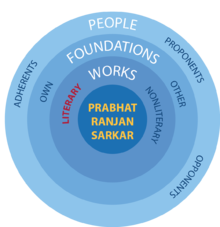Sadhana
| Sadhana | |
|---|---|
| Speaker | Shrii Shrii Anandamurti |
| Date | 1956 |
| Place | Jamalpur |
| Included in | Ananda Marga Caryacarya Part 1 |
| Location in Sarkarverse |
 |
Sadhana is the 3rd chapter of Ananda Marga Caryacarya Part 1 written by Shrii Shrii Anandamurti.[1]
Chapter synopsis
In this chapter Shrii Shrii Anandamurti told, the goal of doing sádhana (spiritual practices) is the all-round elevation of human beings. He told that sadhana does not teach the sádhaka (spiritual aspirant) renunciation of the world but rather the proper utilization of the subtle and crude potentialities.
Anandamurti told, to develop a healthy body and mind, the following items must be strictly followed—
| Yama (Restraint) | |
|---|---|
| Ahiḿsá (Benignity) | Thinking, speaking, and acting without inflicting pain or harm on another |
| Satya (Benevolence) | Thinking and speaking with goodwill |
| Asteya (Honesty) | Not taking or keeping what belongs to others |
| Brahmacarya (Ideation) | Constant mental association with the Supreme |
| Aparigraha (Frugality) | Non-indulgence in superfluous amenities |
| Niyama (Regulation) | |
| Shaoca (Cleanliness) | Physical and mental purity, both internal and external |
| Santośa (Contentment) | Maintaining a state of mental ease |
| Tapah (Sacrifice) | Acceptance of sufferings to reach the spiritual goal |
| Svádhyáya (Contemplation) | Clear understanding of any spiritual subject |
| Iishvara Prańidhána (Dedication) | Adopting the Cosmic Controller as the only ideal of life and moving with ever-accelerating speed toward that Desideratum |
| Intent is primary, but both intent and action should conform if possible. | |
Yama Sadhana and Niyama Sadhana
One should learn special instructions regarding the items of Yama and Niyama from an ácárya/á. The potentiality of an ideal humanity is inherent in Yama and Niyama. Those who are established in Yama and Niyama attain emancipation from the aśt́apásha and śad́aripu arising from Avidyá [the extroversial force]. In this connection it is important to remember that overcoming the aśt́apásha and śad́aripu is not the same as eliminating them. In order to survive, one will have to maintain these páshas and ripus, but you should not be subservient to them, rather they should be subservient to you.
Asana
Anandamurti described Asanas as postures in which one can remain in physical comfort and psychic composure. The practice of asanas cures the body’s glandular system of all its maladies and helps the mind to attain balance for spiritual practices. He also suggested that asanas should be practised only after obtaining instructions from an ácárya/á.
Pranayama
Pranayama is the scientific process to control respiration and hence the mind, as a result of which sadhana is especially facilitated. Anandamurti told, there is an inseparable relationship between the váyus of the body (ten basic energy flows) and the mind. Unsteadiness of respiration means unsteadiness of mind and vice versa.
He also told, the practice of meditation becomes difficult if meditation is not properly practised. Pranayama must be learned from a tranied acarya/a, else it might be harmful.
Pratyahara
The word pratyahara literally means "withdrawal" — withdrawing the unsteady mind from the allurement of particular objects.
Dharana
Dharana is the process to concentrate the mind on a certain point.
Dhyana
- Main article: Meditation
Dhyana or meditation is the unbroken flow of the mind-stuff, or citta, in one continuous stream, like the flow of oil, where all the propensities of the mind are fixed on the goal..
Samadhi
The state in which the tendencies of the mind are completely suspended following the practice of dhyána is called nirvikalpa samádhi.
References
| Preceded by The Process of Initiation |
Ananda Marga Caryacarya Part 1 1956-1991 With: Sádhaná |
Succeeded by Táttvika, Ácárya/á, and Purodhá |

